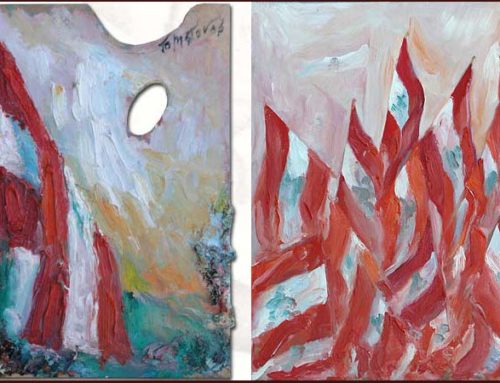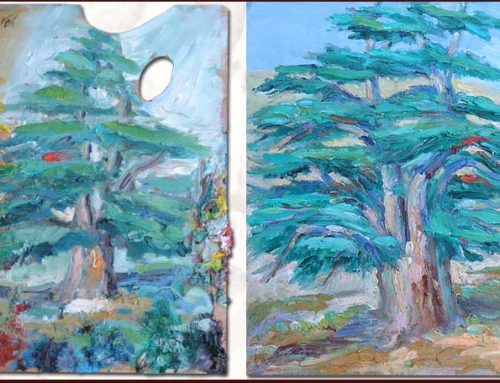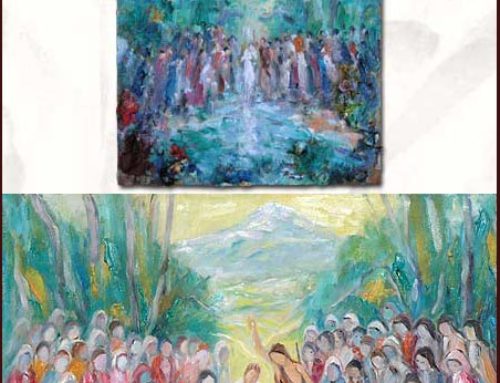The Tree, My Soul
Man creates civilizations, is an artist, a poet, a builder, a researcher, a scholar, in every way trying to do the work of the Almighty … and why not? Or at least he may imitate Him by obtaining works of art for himself. “And the Lord formed man of the slime of the earth, and breathed into his face the breath of life; and man became a living soul.” (Genesis 2: 7) Here one sees the supreme artist at work. Are we not born free, intelligent, capable and artists like He is? But let us not forget this second soul of ours, that is to say our environment, pathways, homes, springs of water, mountains, plains, forests, and … trees! I wish to consider here the tree, for which we use all the adjectives that we use for a man. It comes up, is small, then grows, and is tended as a loved child is tended. It is watered and the soil around it enriched. It lives and breathes and its life may stretch over thousands of years. The sequoia soars hundreds of feet and lives two or even three thousand years.
Wherever it is planted, the tree accompanies humankind, contributing to man’s rejoicing and happiness and life as a whole. Fifty years ago when I was living in Paris at the Lebanese Hostel, a reverend German monk and university rector was speaking of civilization one evening and said; “There are factors, three elements outstanding among the others, that are the foundation of any civilization, man (free, able, just and true), the book (preserving memory and handing on these human values) and the tree! He meant every kind of tree without distinction. The book contains all the record of the past and all the learning hoarded over the centuries, while the tree is the witness and the tractable transmitter of all evolution. There are places on earth crossed by rivers and abundantly watered, but where one sees no tree and no sign of life. Growing trees supposes a firm will and knowledge, and it is of the virtues of the tree that I wish to speak and most of all of those of the tree in Lebanon.
Lebanon, a country famous and illustrious because of its trees, had at the beginning of the twentieth century a forest coverage of over 90% of its territory, now reduced to a mere 15%. In fifty years’ time there will be hardly any trees left in Lebanon. Everybody wishes to rush up buildings and has no intention of planting trees. “All very well to build, but to plant? Passe encore de bâtir, mais planter?” said la Fontaine on one occasion. There is no more continuity of tradition, use and custom. The use of wood in the fires of certain arts and crafts has practically disappeared, forgotten by the baker, the pastry cook, the potter, the blacksmith, the glass blower, the carpet weaver, and the producer of chocolate, liqueurs and sweets. The owner of a workshop or factory, the farmer and the raiser of livestock, have little wish that their sons should carry on their skills and traditions; they prefer to direct their offspring’s ambitions to becoming doctors, engineers, officers, computer scientists or bankers, with greater opportunities for acquiring wealth.
Alone, the tree, our daily companion, is still there unaltered. Trees deeply rooted for centuries, whose trunk is weathered smooth like the rock, like some ancient ruined wall telling the story of the past! There are trees thousands of years old, living temples that speak of a mysterious and inspiring nature, companions of every moment and of every season!
To speak of those that surround us here, there are four thousand species of flora cataloged in Lebanon, whereas in the whole of Europe there are only some 4,800. A tree stands for a presence a thousand years old, and indeed one sees some that have seen thirty centuries roll by, with many civilizations and hundreds of generations of mankind. They stand there undaunted, defying time, cedars, olive trees, sequoias and baobab. The history of a tree is one of sharing our joys and our sorrows, another self of ours, generous, kind and friendly, sharing all our moods, discreetly protecting from sun and from rain.
How often it spreads its shade over our trysts, our games, our siestas and repose, close to its trunk! “The school under the oak tree”, such was the school of the old parish priest. The oak tree graced the public square, and various varieties of trees gave their names to quarters of the city, such as a sycamore or nettle tree at Gemmayseh, an olive tree at Zeitouneh, a fig tree at Tineh and a walnut tree at Tineh at Jawzeh.
The spirit blows like a breeze and gives light in these blessed branches. From the Phoenician Sea or from the desert spaces, one may see the great chain of our three mountains capped by eternal snows. From either Cornet es-Saouda or Sannine or Hermon one may contemplate the other two summits, which rise up majestically and form a noble trinity. Streams of water gush up from the ground so that the inhabitants need never fear going thirsty. One never needs to walk more than a few miles to be able to slake one’s thirst, and then to be filled with love for the Creator of the world.
From north to south, different species of trees are to be found in succession, depending on the altitude: cedar, pine, fir, larch, eucalyptus, nettle tree, hair oak and juniper. Along the water courses there are willow, poplar and plane.
Once upon a time, ships with hulls of cedar or pine sailed off to lands of dreams and enchantment. The Phoenicians crossed the seas to export our trees and our wood to the four corners of the earth. As for the vine planted by Noah, the olive and the carob tree, the almond, the lemon, the apple and the prune, we shall speak of them later. The sky, the sun, the light, the shade, the reverberations, everything is different here and bears witness to a character unique.
Did not David in his psalms sing the praises of this wonderful Lebanon and its trees? And in Judges chapter 9 is there not the story of the trees wanting to anoint a king over them? Prayer in the woodland glade has a sacred touch, coming out of the heart to reach up to God. Here is a presence that carries the soul away. Our churches built of stone have columns with carved leafy capitals, forming trees which recall the primitive rites of worship offered to the gods in the forests. The light filtering through them is both oriental and Lebanese and stands apart from all other light, Nordic, desert, Arctic or Nipponese. Light, earth, air and water, the elements, interpenetrate. The horizons have a human depth and the desert mirage has no place, neither have the oceanic boundaries; here one feels that beyond the horizon something waits, love with human personality.
Eventide here is not only beautiful and serene; it is sublime and deeply moving, our whole being vibrating to the bonds that attach it to the Lord God. The changing tints of the landscape follow each other all day long, sunrise, mid-morning, midday, sunset, twilight, nightfall and then starlight from gleaming points in the dark vault of heaven.
The lights are always new and virginal. There is the Virgin of the Rocks, the Virgin of the Meadows and the Virgin of the Fortress, and there one may meet the Virgin of the Lights, of the Fountains, and of the Springs, whose waters quench thirst for eternity.
The cypress, whether in stands or soaring up alone, imposes itself by its giant size on the city streets, in Ashrafiyeh or in the garden of the school of the Brothers at Byblos. There this tree tells the greatness of the past and the visions for the future.
The pines, the larches, and the turpentine trees, from which resin is extracted, all are embraced in an aerial view which presents an ocean of a thousand shades of green. Palm trees wave their heads along the coast, dangling bunches of red or yellow dates, and can grow on heights of well over a thousand feet.
Along the horizon trees stand guard, to tell that they surround a land of welcome and hospitality. Between the seashore and the mountain tops every kind of tree can find a place to grow; orange trees, banana trees, apricot trees, olive trees, almond trees, pear trees apple trees, cherry trees, and the vine growing everywhere.
In this mosaic of trees story and tradition wish to show a relation between the culture of different kinds of trees and the different religious divides. Two communities, the Maronites and the Shiites, were largely peasants living either in the plains or in the mountains who were persecuted during the years of foreign occupation. The first group planted mostly apple trees and cultivated potatoes in the ground, the latter providing basic food all the year round. The Shiites for their part planted tobacco alongside their olive trees.
The apple trees grew best on the heights with their winter cold and so were an affair for the Maronites. I remember that, when over sixty years ago we visited relatives or friends in the plain of the Beqaa Valley, we would take away as a present a crate of apples. The olive tree, widespread in Koura and in Hasbaya and Rashaya in the Lebanese South, was cultivated by the Greek Orthodox and the Druze, so it had an Orthodox connection. The orange tree cultivated in the coastal plains of Tripoli and Sidon by the Sunnites took on a Muslim association.
The vine, which was cultivated in the plain of the Beqaa around Zahleh, where there were wine-presses, distilleries and cool cellars in abundance, had the Greek Catholics to tend it.
There was a time when it was possible to own a tree growing on somebody else’s land, but not any kind of tree, only a carob. A carob tree can give anything between two hundred and a thousand pounds of shucks full of beans, which meant between one hundred and five hundred pounds of sweet treacle rich in metal oxides and basic nutrients. Sugar was not generally known, while honey was the luxury of the few, so there still exist in the archives deeds of ownership for carob trees standing on the land of another proprietor.
If we peruse the ancient texts, such as those of Holy Scripture and of the Gilgamesh epic, we see the importance given to the tree, as a symbol with its commanding presence and vital unity. But when in the Holy Bible mention is made of a tree it is to Lebanon as a whole that is alluded to: “…see … this goodly mountain, and Libanus,” said Moses. (Deuteronomy 3: 25)
Consider the tree of life that God planted in the middle of his Garden of Eden. (Genesis 2: 3 and 2: 17) He forbad the man to eat of this tree of life, for then he might live eternally. Near the tree of life God had also planted the tree of the knowledge of good and evil. Let us see the allusions that follow:
– Destroy all the places in which the nations that you shall possess worshipped their gods upon high mountains and hills, and under every shady tree. Deuteronomy 12: 2.
– Yet I planted thee a chosen vineyard, all true seed. Jeremiah 12: 21.
– He (the pious man) shall be like a tree which is planted near running waters, which shall bring forth its fruit in due season.” Psalm 1: 3.
– The tree which thou sawest was high and strong, whose height reached to the skies and the sight thereof of all the earth. And the branches thereof were most beautiful and its fruit exceeding much, and in it was food for all, under which the beasts of the field dwelt, and the birds of the air had their abode in its branches. It is thou, O king, who art has grown great and become mighty… Daniel 4: 17-19.
– A tree hath hope. If it be cut it groweth green again, and the boughs thereof sprout. Job 14:7
– The kingdom of heaven is like a mustard seed … which is indeed the least of all seeds: but when it is grown up it is greater than all herbs and becometh a tree, so that the birds of the air come and dwell in the branches thereof. Matthew 13 31, 32.
– The LORD your God is bringing you into a good land with streams that flow from springs in the valleys and hills. You can dig for copper in those hills, and the stones are made of iron ore. And you won’t go hungry. Wheat and barley fields are everywhere, and so are vineyards and orchards full of fig, pomegranate, and olive trees, and there is plenty of honey. Deuteronomy 8: 7-9
– She is a tree of life to those that lay hold on her: and he that shall retain her is blessed. Proverbs 3: 18.
– The fruit of a just man is a tree of life: and he that gaineth souls is wise. Proverbs 11: 30.
– A peaceable tongue is a tree of life… Proverbs 11: 4.
– … To him that overcometh I will give to eat of the tree of life which is in the paradise of my God. Apocalypse 2: 7.
– In the midst of the street thereof, and on both sides of the river, was the tree of life, bearing twelve fruits, yielding its fruits every month: and the leaves of the tree were for the healing of the nations. Apocalypse 22: 2.
– Blessed are they that wash their clothes in the blood of the Lamb: that they might have a right to the tree of life and may enter in by the gates into the city. Apocalypse 22.: 14.
– The glory of Libanus shall come to thee, the fir tree and the box tree and the pine tree together, to beautify the place of my sanctuary. Isaiah 60: 13.
– So Abraham removing his tent came and dwelt by the Oak of Mambre. Genesis 13:18.
– … And he took a great stone, and set it under the Oak that was in the sanctuary of the Lord. Joshua 24: 2.
Lebanon was an immense and deep forest where the Pharaohs, Nabuchodonosor, Solomon and many others came to find the precious woods to decorate their palaces, their temples and their sanctuaries, as is carved in magnificent cuneiform writing on a rock at Wadi Brissa: “I cut many tall and strong cedars of great beauty and of incorruptible aromatic wood .. and I had them carried to Babylon to decorate my palace and the temple of our god Mardouk…”
Joseph Matar
All rights reserved © LebanonArt
Translated from French: K.J.Mortimer







